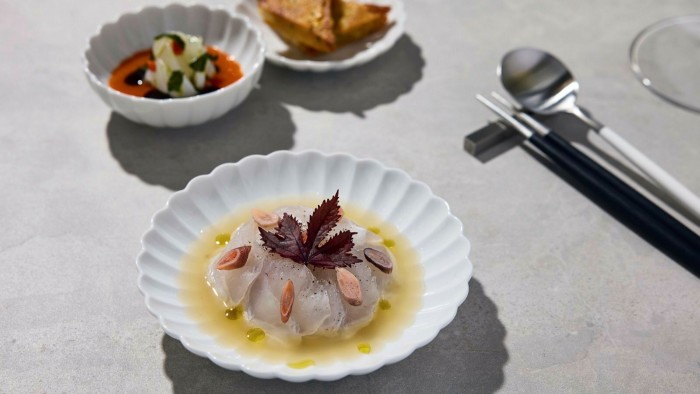This article is part of FT Globetrotter’s guide to Miami
There was a moment in 2021 when every other restaurant opening in Miami was — suddenly and specifically — a high-end omakase concept. The city’s love affair with these Japanese establishments — where menus are a surprise and guests are left entirely in the hands of the chef, who chooses based on what is freshest or in season — stretches back to 2009, when Naoe opened its doors in a nondescript space in Sunny Isles Beach, north Miami (it moved to Brickell Key in 2012). Without any bells and whistles, the restaurant focused on peak-seasonal Japanese ingredients, prepared in various ways — steamed, simmered, fried — and as nigiri courses by chef-owner Kevin Cory.
It wasn’t until years later, however, that other omakase spots began to pop up. The Den and Hiden, both “secretly” tucked inside other restaurants (the former in the more casual sushi restaurant Azabu in South Beach, the latter in a Wynwood taco shop), were forerunners of a post-pandemic flurry of openings.
Today, omakase restaurants are plentiful — from more affordable neighbourhood counters to see-and-be-seen hotspots — but few truly approach the craft and guest experience with a high level of dexterity. Those that do include both traditional Japanese establishments and hybrid versions, drawing on the chef’s own heritage or training, adding Latin — Peruvian, Mexican, Honduran — and Filipino influences.
Shingo
112 Alhambra Circle, Coral Gables, FL 33134
-
Good for: Special occasions. The restaurant was hosting five birthday celebrations during my visit
-
Not so good for: Those coming from Miami Beach. Shingo is in Coral Gables; it can take up to an hour to get there by car
-
FYI: The restaurant also houses an art gallery that features rotating exhibits of ceramics, glassware and wall art
-
Courses and price: 18, $275
-
Seats: 14
-
Seating times: Tuesday–Saturday, 6pm and 9pm
A dining experience at Shingo is sincere, thoughtful and truly welcoming. Seated along a 30-foot hinoki-wood counter, guests are swiftly offered a complimentary glass of champagne in delicate handblown glasses. Small tatami mats are provided for mobile phones on the table, and purses are kept in a basket behind the seats.


The food follows a traditional Japanese omakase, with ingredients sourced from Japan and across North America. Chef-owner Shingo Akikuni is a fourth-generation sushi chef from Osaka who honed his craft at Ginza Sushi Aoki in Tokyo. Here, his seafood is sourced from Tokyo’s Toyosu Fish Market, as well as from high-end US and Canadian suppliers. Uni, for example, comes from both Santa Barbara (as part of the sashimi course) and Hokkaido (as a nigiri course); a charcoal-grilled unagi is from Nagasaki, topped with a generous serving of Kaluga caviar, while akami, chutoro and otoro tuna come from Nova Scotia. Halfway through the nine nigiri courses, Akikuni and sous chef Yuta Sakakibara switch places so that guests can interact with both chefs.
Beverage director and restaurant manager Kaori Yoshioka also curates a thoughtful wine-and-sake pairing. On my visit, the limited-release Masumi Hiyaoroshi Junmai Ginjo sake from Nagano (available only in autumn) was a sublime accompaniment to the melt-in-your-mouth kawahagi (trigger fish).
Ogawa
7223 NW 2nd Avenue, Miami, FL 33150
-
Good for: Flexibility. “We are not stiff when it comes to things like tardiness, scents and attire,” says owner Álvaro Perez Miranda
-
Not so good for: Your bank balance. Ogawa is currently the most expensive omakase in the city
-
FYI: Its sibling Japanese restaurants in Miami includes Hiyakawa in Wynwood (tasting menu and à la carte), the fast-casual Wabi Sabi on the Upper East Side, and Midorie in Coconut Grove
-
Courses and price: 19 to 22, $350
-
Seats: 10
-
Seating times: Tuesday–Saturday, 6pm and 9pm
Ogawa opened in Miami in November 2023 and was immediately awarded a Michelin star in the 2024 Guide. It currently offers the widest breadth among the city’s traditional Japanese omakase restaurants in terms of textures and temperature — an assortment of cold and hot dishes, prepared with precise techniques.


In a dining room inspired by a traditional Japanese minka house, a 10-seat counter is overseen by Osaka-born chef Masayuki “Masa” Komatsu, who has devoted nearly two decades to the art of Edomae sushi. Dishes might include lightly simmered wild yellowtail in a dashi broth; langoustine tempura served with Japanese mountain potato and lotus root in a sauce made from roasted langoustine shells; unagi crisped up on a binchotan grill and glazed with kabayaki sauce, prepared by chef de cuisine Jamie Liu. There are typically eight to 10 nigiri courses and 99 per cent of the ingredients — including 20 to 30 types of fish each week and the Hitachi Wagyu beef — are flown in from Japan.


To drink, I stuck to Pierre Péters blanc de blanc (they have plenty of grower champagnes) and white burgundy from Remoissenet Père Et Fils, but director of operations and sommelier Luis Martinez also does pairings that lean on the more classic wine regions alongside limited-release sakes. Some evenings, Venezuelan-born owner Álvaro Perez Miranda — the first Latino Goodwill Ambassador for Japanese Cuisine in the US, who spent 15 years in Japan before opening Japanese restaurants in Miami — may offer a complimentary sake “kanpai!” to all diners.
Mila Omakase
800 Lincoln Road, Second floor, Miami Beach, FL 33139
-
Good for: Vegans and vegetarians. Fantastic meat-free omakases can be arranged with advanced notice
-
Not so good for: Those who just want to dine in their athleisure — there is a dress code to adhere to
-
FYI: Mila also houses a rooftop restaurant, a lounge and a members-only club
-
Courses and price: 12, $195
-
Seats: 10 (12 for a group reservation)
-
Seating times: Tuesday–Saturday, 7pm and 9.30pm

Asín tibuok — one of the rarest salts in the world, originating from the Philippines’ Bohol province — can currently only be found in Miami at Mila Omakase, according to the restaurant. Executive chef Reiji Yoshizawa, who is of Japanese and Filipino descent, shaves it over akamutsu (blackthroat sea perch) nigiri and buro, a Filipino delicacy of rice fermented with seafood (in this case sea bream) for several days. To finish, it is drizzled with calamansi, a Filipino citrus. This artistry exemplifies the exciting interplay of cultures: Japanese tradition is married with Filipino influences but also French-Mediterranean techniques — courtesy of French-born head of culinary Michaël Michaelidis, who spent 12 years with the Robuchon group in Asia.

In an intimate room with a cherry blossom tree, each team member is introduced to the diners by the hostess. The ringing of the central bronze gong signifies the start of the meal and guests are offered plum wine. I especially loved the starters, which were like art on a plate: tarabagani (king crab) flavoured with yuzu kosho and shiso on a nori tart; hon maguro (bluefin tuna tartare) topped with Kaluga caviar on a sweet and savoury charcoal meringue; and kinilaw — the Filipino-style ceviche of shima aji (striped jack fish), inspired by Yoshizawa’s grandmother’s version made with dilis (sweet and spicy dried anchovies) and encased in delicate feuilles de brick.
The sake-and-wine pairing is also omakase — there’s no menu — and is tailored to each individual. Bulgarian-born sommelier Tsvetan Troshanov asked if there was anything I didn’t like or don’t drink and then crafted a pairing on the spot. My highlights were the snow-aged Junmai Daiginjo sake from Hakkaisan and a beautiful white blend from Cassis, made by Clos Sainte Magdeleine.
Itamae AO
3225 NE 1st Avenue, Miami, FL 33137
-
Good for: Those seeking exciting, unexpected flavour combinations
-
Not so good for: Anyone looking for a traditional Japanese omakase experience. Here it comes with a Peruvian twist
-
FYI: Itamae AO is part of a restaurant group owned by the Chang family, originally from Chiclayo in Peru. It also includes B-Side Sushi at 1-800-Lucky, the Asian food hall in Wynwood, and Maty’s, a contemporary Peruvian restaurant adjacent to Itamae AO
-
Courses and price: Eight (with multiple dishes per course), $165
-
Seats: 10
-
Seating times: Tuesday to Saturday, 5pm, 7pm and 9.15pm

Itamae has long been one of Miami’s most beloved restaurants, known for its umami-laden Peruvian-Japanese (Nikkei) cuisine. It closed its Design District location in August 2023 and reopened last May in Midtown as Itamae AO — now an omakase-only concept headed by chef-owner Nando Chang. “We are at the intersection of Japanese techniques and Peruvian flavours,” says Chang, who trained as a sushi chef with his father, Fernando.
As guests sit at a terrazzo countertop overlooking what was designed to feel like Chang’s personal kitchen, courses come as multiple small plates — instead of the one-bite-per-course. Depending on the season, you might enjoy a muchame (a type of cured seafood) of swordfish belly, served in a tomato dashi; a ceviche of aori ika (bigfin reef squid) in a yuzu and ika (squid) leche de tigre, served with huacatay (an Andean herb); or spiny lobster with marinated ikura (salmon roe) and crispy sweet-potato gnocchi in a broth.


There are only two nigiri courses but they are explosive in flavour and hard to find elsewhere: an algae-cured hotate (scallop) with apple banana cream, ají charapita (an Amazonian pepper) and Ossetra caviar; and lightly torched Shinshu salmon topped with a fermented longan caramel and ají chiltepin (a small, very hot pepper). Dry-aged fish is also an Itamae AO speciality; some varieties are aged for up to 180 days.
My friend and I enjoyed our meal with a bottle of Anjou Blanc by Thibaud Boudignon, but sommelier Katerina Lopez also serves sake, shochu and whisky. Her pairings involve different spirits alongside low-intervention wines.
El Secreto
3201 Collins Avenue, Miami Beach, FL 33140
-
Good for: Social butterflies. The space is for only six guests per seating and it’s not uncommon for them to start mingling
-
Not so good for: Larger parties
-
FYI: El Secreto shares a drinks menu with sibling restaurant Pao, which offers great cocktails crafted by mixologist Ritz Sagum. The ultra-fun take on a piña colada is made with ube-infused vodka, coconut rum, toasted pineapple and lemon, and served in a golden horse figurine
-
Seats: Six
-
Courses and price: 15, $295
-
Seating times: Tuesday–Saturday, 6.30pm and 9pm

Truffles, caviar and 24-carat gold are often described as “very Miami” — and they are certainly not in short supply at El Secreto. This onyx- and gold-panelled speakeasy-style omakase restaurant is part of the Faena Hotel Miami Beach, tucked behind the Faena Theater and private wine cellar La Cava. The menu — designed by Filipino-American Paul Qui, a Top Chef alumnus who helms the hotel’s pan-Asian restaurant Pao — combines Japanese technique and traditions with Latin flavours, nodding to the Honduran and Mexican heritages of, respectively, sushi chef Erik Melendrez and sous chef Carlos Islava.


Expect dishes such as Fanny Bay oysters dressed with umeboshi (pickled plum) mignonette and topped with ikura and 24-carat-gold flakes; chawanmushi (savoury egg custard) adorned with Alba truffles and Ossetra caviar; and butternut squash miso soup, made extra-indulgent with a dashi of aged jamón ibérico, cubed foie gras and black truffles. The nigiri of golden eye snapper topped with Mexican macha (dried chilli) and the kinki (thorny rock fish) topped with ají amarillo (a hot South American chilli) and calamansi both evoke fiery Latin flavours. There are also sashimi courses of akami, chutoro and otoro, the bluefin tuna sourced from Baja, Mexico and dry-aged for two weeks.
Melendrez explains each dish with clarity, ensuring that guests learn about the ingredients, preparation methods and flavour combinations throughout the evening. El Secreto is one of the most indulgent omakases in Miami, both visually — with plenty of gold everywhere, from the interiors down to the ingredients — and in flavour.
Where do you go for omakase in Miami? Tell us in the comments below. And follow FT Globetrotter on Instagram at @FTGlobetrotter
Cities with the FT

FT Globetrotter, our insider guides to some of the world’s greatest cities, offers expert advice on eating and drinking, exercise, art and culture — and much more
Find us in Miami, Copenhagen, Paris, Rome, London, Tokyo, New York, Frankfurt, Singapore, Hong Kong, Toronto, Madrid, Melbourne, Zürich, Milan, Vancouver, Edinburgh and Venice









